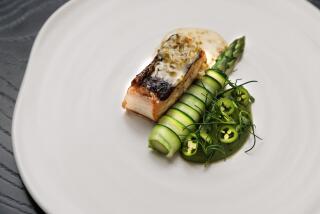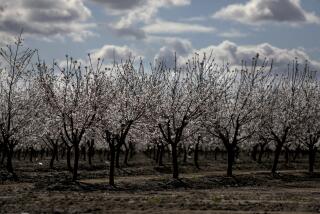Building Up California Abs
There once was a time when abalone, this most succulent of shellfish, was plentiful along the Pacific Coast of North America. Within barely a generation, however, the delicate mollusk and its distinctive ear-shaped shell has become a rarity in the wild, a victim of gastronomic overkill. Experts have several explanations for this unfortunate depletion. The main reasons include overfishing and illegal gathering of undersized abalones.
Abalones also suffer from the gluttonous appetite of such natural predators as California sea otters, whose taste for it rivals that of discriminating epicures. These various factors account for the 90% drop in commercially available wild abalone over the past 30 years, principally along the Southern California coast.
Luckily, there is new hope for American abalone fanciers. Thanks to a handful of forward-thinking aquaculturists who have established commercial abalone “farms,” Pacific red abalone is making a domesticated comeback. The endeavor requires intensive scientific research as well as staggering amounts of patience, for abalone in the shell grows only one inch a year and requires up to three years before it reaches marketable size.
Biologist John McMullen, a 20-year veteran of abalone production and founder of AbLab in Port Hueneme, Calif., was one of the first to farm abalone. He specializes in live, three-inch California-farmed abalone in the shell.
*
“We want people to know they’re really eating abalone,” he explains. “There’s a lot of consumer education involved. Abalone is still relatively unknown outside California.”
At AbLab, the abalone is nurtured from the egg stage, when it is tinier than a grain of sand, to marketable size. For three years, the pampered mollusks feed on sea water and fresh kelp in large round tubs located within a few feet of the beach and cooled by fresh ocean breezes. The end product is so tender that “we don’t even need to pound it into a steak,” says McMullen.
Farther up the California coast, Pacific Mariculture occupies the edge of a low, scraggly cliff a few miles north of Santa Cruz. Fittingly, the farm lies in the shadow of the oldest Indian midden (prehistoric refuse mound) in California, a pile consisting largely of discarded abalone shells; it once belonged to the Alones--whence the name abalone. The shimmering blue crescent of Monterey Bay serves as a backdrop. In the distance, glistening acres of kelp nurture some of the best fishing grounds in the state, a fact not lost on the army of sea gulls and brown pelicans floating lazily over the waves.
Home to one of the world’s richest ecosystems, this area was recently declared a marine sanctuary. The fresh sea water of Monterey Bay is continuously pumped into the 400,000-gallon tank towering over the Pacific Mariculture acres--water that, in turn, is funneled into dozens of fiberglass tubs brimming with abalone in various stages of growth. In some tubs, seedlings are so small as to be almost invisible to the naked eye. In others, clouds of bubbles breaking through the blanket of fresh kelp are telltale indicators of the “baby” abalones’ healthful appetite.
*
Pacific Mariculture maintains close ties with the University of California-Santa Cruz (and also with Stanford University), which advises the company in matters of animal selection and improved breeding techniques.
“We saw what the future would be,” says Pacific Mariculture’s president, Dr. Peter Scrivani, a founder and researcher for the project. “It’s simply old-fashioned farming with a college education.” Their most popular product is the Petite 1 3/4-inch abalone, popular with Bay Area chefs.
Like their colleagues at Pacific Mariculture, Chris and Linda Van Hook of ABALONE International in Crescent City, Calif., have spent years perfecting their product.
“We should have been bank tellers; we would have made more money,” says Chris Van Hook, whose hearty laugh belies the fact that he spent eight full years exploring the Pacific Coast from Baja California to Vancouver, securing the perfect site and the permits that would allow him to grow ocean-raised abalone. Crescent City’s wide oceanic harbor, close to the Oregon border, fit the bill perfectly for Van Hook to fulfill his ambition.
*
The year 1988 marked the beginning of ABALONE International and a 40-year lease in the waters of Crescent City Harbor. Armed with a B.A. degree in environmental studies from the University of California-Santa Barbara, the aquaculturist started toying with the idea of producing abalone commercially as far back as 1976.
“Nearly all land-based farms were started in the ‘70s when energy wasn’t a major consideration,” he says. “We set about it totally the opposite way. We asked ourselves, where should we go? Rather than remaining landlocked, I preferred to go out in the ocean with my cages.”
In a departure from most other similar ventures, Van Hook’s abalones grow in cages hanging from a long floating dock, inside converted plastic barrels that have had top and bottom removed and replaced with plastic mesh to allow for free circulation of sea water. When they reach 39 millimeters in size, the juvenile abalone are transferred to large, rectangular plastic mesh cages that hold vertical panels. The abalone attach themselves to the panels in the same way they attach to rocks in the wild.
A labor-intensive feeding process ensures correct nutrition, requiring kelp to be gathered from wild kelp beds (for which a small fee is paid to the state), then brought to the farm site and cut up into small pieces before being fed to the developing abalone. Three years later, the three-inch mollusk will be ready for market, a lengthy process by any stretch of the imagination, and one that explains the abalone’s relatively high market price.
*
A sideline of ABALONE International’s commitment to sound environmental practices is its cooperation with the Del Norte County Abalone Replant Program. Funds gathered through fines levied by the county’s fish and game department purchase three-quarter-inch abalone in order to “replant” them in the rocks lining the county shoreline. Through such programs, hopes Van Hook, wild abalone might once again thrive in California waters.
At US Abalone in Princeton, south of San Francisco, farming is also a family operation. Tom Ebert, an aquaculture scientist and a veteran of 17 years in abalone research and production, holds a master’s degree in marine research from the Moss Landing Marine Laboratory in California. He credits his father, Earl, a research director at the California Department of Fish and Game for more than 30 years, with being one of the pioneers in abalone research in the state. Ebert’s brother, David, who holds a Ph.D. in marine ecology and fisheries science, is now in charge of expansion and development.
US Abalone actually consists of two operations: one on land and the other at sea. At the Santa Cruz facility, the abalone is raised in raceways, or long troughs, continually fed sea water and seaweed.
At the open ocean location in Pillar Point Harbor, abalone are raised in large cages suspended from 20-by-12-foot rafts just inside the breakwater.
*
“The flavor of the meat depends upon food and water quality,” explains Tom Ebert, who, like his colleagues, sees a tremendous national potential for farm-raised abalone. “Much of our success in marketing our product domestically depends on educating the public.”
Although national consumption is increasing, thanks to many upscale chefs’ predilection for the product, much of the California abalone production is still bound for the Japanese market, which tolerates premium prices. Thanks to these commercial producers, American consumers may well join in the abalone feast once again.
*
Chris Van Hook credits his friend Diane Davies with developing this recipe. “Don’t forget to save the shells,” he advises. “They make beautiful containers for the sauce.” Placed in the refrigerator on a drain board so they do not sit in water, abalone will stay alive for three days, and fresh for four additional days. Abalone can also be prepared immediately and frozen between layers of wax paper.
ABALONE IN JADE SAUCE 10 (2 1/2-inch) abalone 2 tablespoons minced ginger root 3/4 pound spinach, rinsed, stemmed and patted dry 1 bunch chives, rinsed and dried 4 sprigs cilantro 4 basil leaves 1/4 cup chicken stock 3/4 cup whipping cream 1/2 teaspoon salt 1/4 teaspoon Chinese chili sauce 1 tablespoon cornstarch 1 tablespoon cold water 1/4 cup butter, cut up Freshly ground pepper
Rinse, tenderize and thoroughly dry abalone scallops. Rub scallops with half of ginger root. Cover and refrigerate until ready to use.
To make sauce, process spinach, chives, cilantro, basil and remaining ginger root in increments until finely chopped in blender or food processor. Add chicken stock and process until fairly smooth. Add cream, salt and chili sauce. Process until pureed. Place mixture in medium saucepan over low heat and bring to simmer.
Meanwhile, combine cornstarch with 1 tablespoon cold water in small bowl. Mix until smooth. Add mixture to simmering sauce. Stir until well blended. Cook, stirring occasionally, until sauce thickens, 2 to 4 minutes longer.
Place prepared abalone on baking sheet. Dot with butter. Season to taste with pepper. Bake abalone at 500 degrees until flesh turns white and is firm to touch, 3 to 4 minutes. Remove from oven. Spoon sauce in pool on dinner plate. Place abalone on top of sauce. Serve immediately. Makes about 4 servings.
Note : To prepare and tenderize abalone, run thin-bladed knife around inside edge of shell to shuck out meat. Discard visceral parts without trimming off dark edges. Then place abalone scallop in plastic zipper food bag. With wooden mallet, using sharp wrist movements, tap flesh repeatedly without ripping apart, working in circular motion, starting from center, to obtain uniform thickness. Repeat same procedure for other side. Or place abalone scallop on lower half of tea towel, fold other half over scallop and pound as directed.
*
This recipe from Pacific Mariculture calls for the small abalone, usually reserved for appetizer-size helpings. Leave the abalone in the shell until ready to use.
GRILLED ABALONE 1/4 cup soy sauce 1/4 cup sake or dry Sherry 2 tablespoons peanut or vegetable oil 2 tablespoons minced ginger root 12 small abalone in shells
Bring charcoal to red-hot stage in outdoor grill.
Mix soy sauce, sake, oil and ginger root in medium bowl. Remove abalone meat from shells and place in marinade. Marinate 10 minutes. Return marinated abalone to shells. Reserve marinade.
Place filled shells, shell side down, on oiled grill. Grill 1 minute, shell will act as receptacle. With tongs, turn shells with abalone over carefully and grill 30 seconds longer until meat is lightly browned. Heat reserved marinade until boiling and use as dipping sauce. Serve abalone in their own shells immediately. Makes 4 servings.
More to Read
Sign up for Essential California
The most important California stories and recommendations in your inbox every morning.
You may occasionally receive promotional content from the Los Angeles Times.








